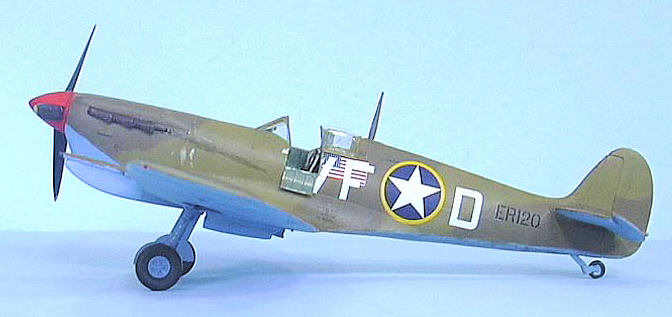
Eduard 1/48 Spitfire Vc
| KIT #: | 1137 |
| PRICE: | $49.95 MSRP |
| DECALS: | Four Options |
| REVIEWER: | Tom Cleaver |
| NOTES: | Reboxed Special Hobby kit with photo-etch detail parts added. |

| HISTORY |
The Spitfire V was originally an “interim” type based on
the Mk.I airframe, specially strengthened to take the additional 475 h.p. of a
Merlin-45 so as to be able to take on the new Messerschmitt Bf-109F that had
first appeared toward the end of the Battle of Britain.
Appearing in early 1941, the airplane was visually
different from the Spitfire I and II in that it had metal ailerons, which
greatly improved controllability and roll rate.
Of course, this distinguishing mark was absent from the
Mk.II Spitfires flown by the Tangmere Wing, led by Douglas Bader, who managed to
bend the rules - something he was very good at - and get Supermarine to equip
the wing’s Spitfires with the new metal ailerons.
Some 200-odd Spitfire Va with the original armament of
eight .303 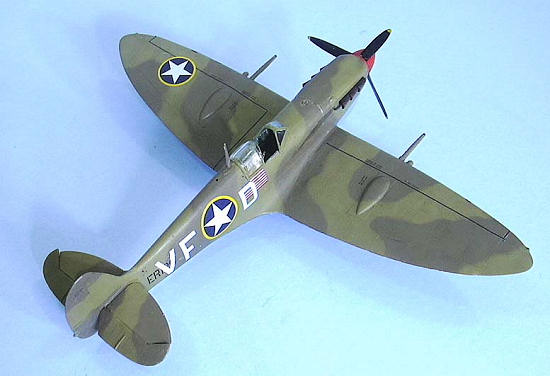 caliber
machine guns were produced, but the vast majority were the Spitfire Vb with two
drum-fed 20mm cannon and four machine guns. This “interim” Spitfire became the
most-produced variant after the Spitfire IX, another “interim” type pushed into
production to deal with another German aerial threat, the Fw-190.
caliber
machine guns were produced, but the vast majority were the Spitfire Vb with two
drum-fed 20mm cannon and four machine guns. This “interim” Spitfire became the
most-produced variant after the Spitfire IX, another “interim” type pushed into
production to deal with another German aerial threat, the Fw-190.
The Spitfire Vc was introduced in late 1941, and can be
compared to the Spitfire Vb in the same way a Spitfire VIII can be compared to a
Spitfire IX, i.e., this version featured a redesigned and strengthened airframe
specifically to take the power of the Merlin-45, and other refinements.
It also introduced the “universal” or “c” wing which
could carry four 20mm cannon or two 20mm cannon and four .303 machine guns, with
the cannon being belt-fed rather than drum-fed.
Very few ever carried the 4-cannon armament as the extra
cannon imposed stresses on the wing and the ext5ra weight had a deleterious
effect on performance and maneuverability. Most Spitfire Vc’s carried the
two-cannon/four-machinegun armament, with the extra space in the cannon bay used
to double the ammo for the two 20mm cannon, with a plug in the leading edge of
the wing over the cannon port.
The Spitfire Vc could also be distinguished from the
previous versions by the fact the undercarriage legs sloped forward 2 inches
further.
2,467 Spitfire Vc’s were built: 478 by Supermarine, 1,494 by Castle
Bromwich, and 495 by Westland,
The Spitfire Vc saw widespread overseas service from
early 1942 onwards.
Most of the Spitfires assigned to the defense of Malta
were of this version. The aircraft was also used extensively by the Desert Air
Force in the North African, Italian and Balkans campaigns, as well as seeing
service with five RAF squadrons in the India-Burma theater.
250 Spitfire Vc’s were also supplied to the RAAF, where
they were flown in the defense of Northern Australia around Darwin, and for
operations in New Guinea and the South West Pacific.
The USAAF was the largest foreign user of Spitfires,
with two fighter groups equipped through reverse Lend Lease operating in North
Africa and the Mediterranean theatre of operations/
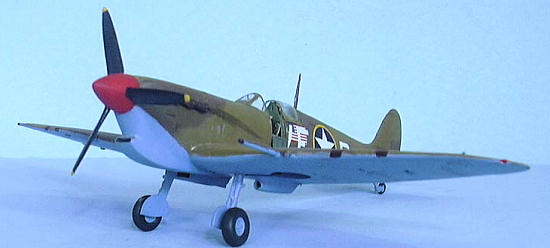 Spitfire
Vc’s were also operated by the Armee de l’Air, the Italian Co-Belligerent Air
Force, the Yugoslav Partisan Air Force, the Royal Hellenic Air Force, the
Turkish Air Force, the Portuguese Air Force, and the Royal Egyptian Air Force.
Spitfire
Vc’s were also operated by the Armee de l’Air, the Italian Co-Belligerent Air
Force, the Yugoslav Partisan Air Force, the Royal Hellenic Air Force, the
Turkish Air Force, the Portuguese Air Force, and the Royal Egyptian Air Force.
The 31st
Fighter Group in North Africa:
The 31st
Pursuit Group, composed of 39th, 40th, and 41st Pursuit Squadrons, was formed
February 1, 1940 at Selfridge Field, Michigan, and was initially equipped with
the P-39 Airacobra. In January 1942 the 39th,
40th
and 41st
squadrons were transferred to the 35th
PG and the 307th,
308th, and 309th
Pursuit Squadrons were formed in their place.
Operation Torch commenced on November 8, 1942. That day, the 308th
FS and 309th FS flew from Gibraltar
to Tafaraoui Airfield, Algeria, where three French Dewoitine D.520s strafing the
airfield as the group was landing were shot down by pilots of the 309th.
The ground echelons arrived that night, with the 307th
FS arriving the next morning. The squadrons engaged in ground attack actions
until November 11, when the French forces surrendered. On November 14, the group
moved to Le Senia, where they provided air defense for Oran. For the rest of the
year, rain and mud greatly limited operations.
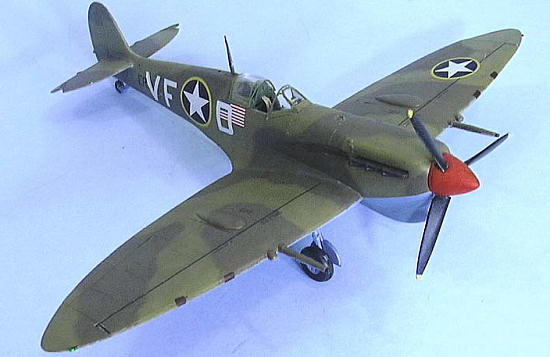 On January 11, 1943 the 308th
FS moved to Casablanca, Morocco to cover the arrival of President Roosevelt and
Prime Minister Winston Churchill. On February 7, the group transferred to
Thelepte, Tunisia, 50 miles behind the front. Conditions at Thelepte were
difficult, with the men living in shelters and dugouts, with frequent Luftwaffe
raids.
On February 15, the 307th
was strafed as they assembled on the runway.
Over the course of the day six Bf-109s Fw-190s were shot
down. On February 17, with Thelepte in imminent danger of being overrun by the
Germans, the Group evacuated immediately and was forced to leave much of their
supplies and equipment behind.
On January 11, 1943 the 308th
FS moved to Casablanca, Morocco to cover the arrival of President Roosevelt and
Prime Minister Winston Churchill. On February 7, the group transferred to
Thelepte, Tunisia, 50 miles behind the front. Conditions at Thelepte were
difficult, with the men living in shelters and dugouts, with frequent Luftwaffe
raids.
On February 15, the 307th
was strafed as they assembled on the runway.
Over the course of the day six Bf-109s Fw-190s were shot
down. On February 17, with Thelepte in imminent danger of being overrun by the
Germans, the Group evacuated immediately and was forced to leave much of their
supplies and equipment behind.
Between February 17 and March 7, 1943, the individual
squadrons of the 31st FG operated
from Tebessa, Du Kouif, Youks-les-Bains, Canrobert, and Kalaa Djerda before they
reassembled at Thelepte. For the rest of March and early April, the squadrons
provided escort for A-20s attacking the Afrika Korps. During this period the
group claimed 15 Luftwaffe planes destroyed. On April 6 the 31st
received their first Spitfire Mk IXs, which were used to provide high cover for
the Spitfire Vc’s.
The Germans were now in retreat and the Group was moved
to Djilma on April 7, 15 miles from the front, then on April 13 to Le Sers.
Flying from Le Sers, the 31st
claimed 29 Luftwaffe aircraft destroyed by the time of the German surrender in
North Africa on May 11, 1943.
With the fighting over, operations slowed considerably for the 31st FG during the rest of May. Pilots were given rest leave and most of the Spitfire Vc’s were replaced with Spitfire IXs and Spitfire VIIIs for the coming invasion of Sicily.
| THE KIT |
For being the third most-produced version of the
Spitfire, and being more widely-used by different air forces than the Spitfire

The Special Hobby kit shows its lineage pretty obviously, being based closely on the Tamiya Spitfire Vb, with some additional plastic parts to box in the cockpit, and separate ailerons. This release by Eduard is a clipped-wing Spitfire Vc with markings for foreign users of the airplane in both standard and tropical versions, including a French Air Force Spitfire, one flown by the South African Air Force, and one with D-Day stripes. The kit only includes parts for the clipped wingtips. A full photo-etch cockpit, including the seat assembly, throttle and other details as well as a multi-part instrument panel and seat belts, is provided, as well as exterior details like the radiator screens and gear doors and wheel well detail.
| CONSTRUCTION |
I began construction with the wing, and made the awful
discovery that the ailerons do not fit the wing!
They are too small as well as too thin.
I fixed this by gluing them in place and then “fattening
them up” with putty and Mr. Surfacer.
This really made
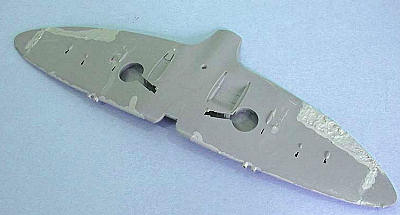 more mess
than was needed, and I would suggest gluing a piece of .010 Evergreen sheet to
the lower surface, reshaping that and then rescribing it as a much superior way
to solve the problem.
more mess
than was needed, and I would suggest gluing a piece of .010 Evergreen sheet to
the lower surface, reshaping that and then rescribing it as a much superior way
to solve the problem.
Other than that, the kit goes together as well as any
MPM kit does, which means test-fit everything and be prepared to use putty and
Mr. Surfacer on all joints and seams.
I elected not to use most of the Eduard photoetch
cockpit detail as it seemed too thin to me, and the plastic parts were perfectly
adequate.
I did use the instrument panel, several of the other instrument
faces, and the seatbelts.
I also elected not to use the photoetch gear doors for
seeming too thin, and did not use the radiator screens on grounds they are so
deep in the cowling that you can’t see them.
I also used a pair of Tamiya extended wingtips, which
fit perfectly, since I intended to do a model of an airplane with a standard
wing.
| COLORS & MARKINGS |
Painting:
I painted the model with Xtracrylix RAF Dark Earth,
Middle Stone and Azure Blue, applied freehand.
When that was dry, I gave the model a coat of Xtracrylix
Gloss Varnish.
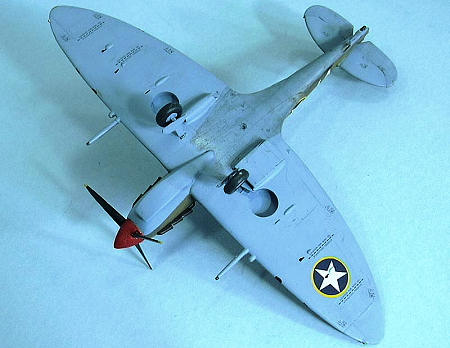
Decals:
The decals in the kit are perfectly adequate and will create some interesting-looking models. I decided I wanted to finally make an American Spitfire Vc, and used the Third Group Decals sheet that had been hiding in the decal dungeon for the past 10 years to do a Spitfire Vc of the 31st Fighter Group, operated in North Africa during Operation Torch. I also used the kit decals for the stencils. Everything went down with no problem using Micro-Sol.
| FINAL ASSEMBLY |
I decided to do the model as the original might have looked at about the time of the invasion of North Africa, so it would be relatively clean and mostly un-dinged. Photos of Spitfires operated in North Africa by the 31st FG show them faded and dinged a lot by the Spring of 1943, so one could really go to town on this scheme if they so wished. After applying some exhaust stains and dings where the pilot would board the airplane, I gave the model a coat of Xtracrylix Flat Varnish with a brushful of Tamiya Flat Base to give it the sun-weathered look that comes quickly in North Africa. I attached the landing gear, prop and canopy, and the model was finished.
| CONCLUSIONS |
Review kit courtesy of Eduard Models.
March 2009
Copyright ModelingMadness.com. All rights reserved. No reproduction in any form without express permission from the editor.
If you would like your product reviewed fairly and quickly, please contact the editor or see other details in the Note to Contributors.